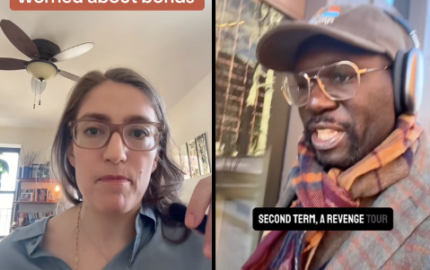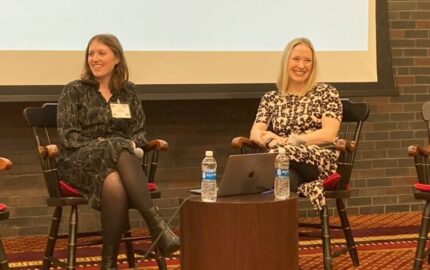Journalism—even that of the literary or narrative variety—must evolve to fit screens big and small, desk-bound and hand-held. More than “theme” and “narrative arc” these days, journalists are thinking “interactivity” and “usability.” Still, powerful nonfiction stories make it to the Web all the time. It’s clear the form of the story often is—and should be—different in order to fit the capabilities of this highly individual, multisensory medium. What’s often unclear is how words best fit into multimedia storytelling.
Interactive Narratives: a showcase of images (and words, too)
For almost two years now, I’ve been analyzing the writing in the highest-rated multimedia presentations on Interactive Narratives, a Web site sponsored by the Online News Association. A showcase of multimedia storytelling, the site is a collection of user-submitted works from large daily newspapers, such as The New York Times, as well as nonprofits and individuals. Somewhat surprisingly, I’ve found words on that site. Many of them.
 As of March 19, Interactive Narratives included more than 1,700 presentations produced by media organizations, nonprofits and individuals. Users, who include multimedia journalists, academics and people working for nonprofit organizations, can rate them in quality. If you’re not an ONA member, you can join or create an Interactive Narratives account in order to contribute something, nominate something or rate presentations and leave comments.
As of March 19, Interactive Narratives included more than 1,700 presentations produced by media organizations, nonprofits and individuals. Users, who include multimedia journalists, academics and people working for nonprofit organizations, can rate them in quality. If you’re not an ONA member, you can join or create an Interactive Narratives account in order to contribute something, nominate something or rate presentations and leave comments.By March 19, 54 English-language presentations* had received five stars, the highest rating. Of those, 16 stories (30 percent) included no writing or minimal writing, such as a brief introduction to the site. Twenty-six (48 percent) featured long-form writing, the sort one might find on the front page of a newspaper or within the feature well of a magazine. Twelve (22 percent) included short-form writing. One presentation was inaccessible.
Given the pervasiveness of write-short edicts, I was both surprised and pleased by the numbers, even though I was fairly certain the stories weren’t being given five stars for the quality of the writing. (The comments rarely mention the words.) Twenty of the 26 long-form text stories were produced by newspapers. Long-form text stories accompanied the online presentations, allowing the reader/viewer to enjoy the full text experience along with multimedia.
But long-form text stories are time-consuming and expensive to produce. Mindy McAdams, Knight Chair for Journalism Technologies and the Democratic Process at the University of Florida, says that in the future, journalists may develop other ways to show depth that does not involve writing. “It may not be necessary for journalism to produce as much long-form journalism as it currently does,” she said. “It may not be the best place to spend resources.”
We’ve been here before
As urgent as this crisis appears to those of us who love words, it’s important to remember that writing needs to evolve in order to survive. As Thomas B. Connery, professor of Communication and Journalism at the University of St. Thomas, explains in “History of the Mass Media in the United States: An Encyclopedia,” newspapers and magazines have always contained the writings of “literary stylists” crafting work of lasting value and deep purpose, but literary form has changed depending on journalism’s role in society, cultural expectations and the owners of the media in which they published.
In the scramble to develop new ways to tell stories, portraying meaning—as opposed to the mere collection and presentation of fact and opinion—remains important. Some news organizations, eager to continue providing literary writing even as resources diminish, are experimenting with shorter forms, including nonfiction poetry, online. “There’s this inevitable movement toward shorter, tighter, quicker,” Poynter Institute Senior Scholar Roy Peter Clark told The Washington Post in October.
I am not suggesting that a story’s short length immediately makes it work on the Web. The advice here is not “write short,” but “write short and well.” An economy of words is essential online, according to Joe Lambert, executive director of the Center for Digital Storytelling. Multimedia, for many, is a primarily visual medium in which other elements, such as text, must augment—not crowd—it.
In his landmark book, Digital Storytelling, Lambert discusses a process called “closure,” in which the viewer recognizes the pattern of information relayed by the producer in “bits and pieces”—images, video, graphics, text—and then completes that pattern in his or her own mind.
In spoken word or a written narrative, we are operating at a high level of closure as we are filling in all the pictures suggested by a text or words from images and memories in our brains. If I start a story, ‘Once upon a midnight dreary . . .’ you are likely to immediately fill in a mental image of a foreboding castle, rainstorms, ravens and the works. . . . Storytelling with images means consciously economizing language in relationship to the narrative that is provided by the juxtaposition of images. There are two tracks of meaning, the visual and the auditory, and we need to think about the degree of closure each provides in relation to the other.
The problem closure presents for literary journalism is obvious: The entire canon of literary journalism consists of words, often very many words. In the past, words have been the medium journalists thought of first, with still images adding drama and evidence. How can the genre transcend its word count for a successful future on the Web?
The nonlinear future of story
For nearly two decades now, fiction writers and poets have made progress in answering this question within their own disciplines. The pioneering digital scholar N. Katherine Hayles describes electronic literature as created for and meant to be read on a computer, generally excluding "print literature that has been digitized.”
The field borrows heavily from key thinkers in literary theory and computer science. George P. Landow's seminal Hypertext 3.0 draws on Jacques Derrida, Roland Barthes, Theodor H. Nelson and Andries van Dam, all of whom theorized that the linear approach must give way to "nodes, links and networks."
Interactivity, as it has evolved with programs such as Flash, seems to be one common thread connecting electronic works—even more so than words. In fact, Hayles contends that electronic works need not include words in order to be “literary.” One-third of the works she has helped select for the Electronic Literature Collection, a sampler of critically interesting electronic fiction and poetry, has no recognizable words at all. They are “literary,” she contends, because they address “the histories, contexts and production of literature.”
Hayles made the first attempt to categorize these diverse works into specific genres, such as Interactive Fiction and the Flash Poem. Hyperlinks characterized the first generation, or the classic era, of such works, according to Hayles. Michael Joyce’s “afternoon: a story” and Shelley Jackson’s “Patchwork Girl” are often cited as the most notable works of this kind. The second generation, better termed “contemporary” or “postmodern” works use a variety of navigational techniques and interfaces. The Flash poem, “Cruising,” by Ingrid Ankerson and Megan Sapnar, for instance, evokes the “coming-of-age ritual” of cruising in small-town America, while allowing the viewer to control—drive, really—the pace of the words. Often, the author, while by no means a passive observer, allows the viewer/reader/user to help create his or her own experience of the work.
Conventional narrative devices, such as rising tension and dénouement, do not transfer easily to electronic literature, Hayles has noted. But “the response to this tension has been a burst of innovation and experimentation.” Both the Electronic Literature Organization and the Electronic Poetry Center catalog such works on their Web sites and advocate for greater recognition and scholarly attention.
Similarly, news gatherers and investigative reporters have produced many innovations online. Links to award-winning examples of commendable database journalism, user-generated reporting and interactive graphics can be found on the Web site for J-Lab: The Institute for Interactive Journalism at American University. The disciplines of Journalism and Computer Science are coming together in interesting ways at Northwestern University’s graduate school of journalism, which offers scholarships to programmers; and Columbia University, which just instituted a dual master’s degree in journalism and computer science. In other universities, including my own, efforts are underway to teach programming to journalism undergraduates and journalism to student computer scientists. Reasons given for these efforts include data mining and more user personalization. I’d like to see the results spill over into more engaging online storytelling.
Those who craft narrative or literary journalism have always used the tools of fiction writers and poets to infuse their prose with meaning. That shouldn’t stop just because journalists are writing for the Web. Just as the New Journalists of the 1960s looked to literature to invigorate their nonfiction, journalists today are doing the same, and it’s likely that experimentation with nonfiction forms online will only grow. In Japan, for instance, writers are crafting bestselling novels to be read on mobile phones, a genre called the “cellphone novel.” Although it’s not as popular yet, cellphone nonfiction is available on cellstories.net. Founder Dan Sinker mixes fiction with nonfiction, so you never know what you’re going to get—only that it's going to be a good read.
“The key thing is it’s got to grab you right away,” he says. “The slow-burn, buried-lead, kind of story doesn’t work because you’re competing against a lot and you’re asking for more than a 30-second interaction. …[But] once the readers hook in, they stay. I look for an ending that has a payoff. Each story is the sales pitch for the next day’s story. "Wow, that was awesome, I’m coming back tomorrow.”
If you take away some (or even all) of the words, the literary can still live, still grow online. In her 2008 book, Electronic Literature, Hayles explains that literature carries its accumulated knowledge from the old medium to the new “by trying to replicate the earlier medium’s effects within the new medium’s specificities.” Modern feature writing lacks critical acknowledgement of its contribution to multimedia journalism. New forms, such as online nonfiction poetry and the map-based feature, must be examined and classified, then embraced and supported, as electronic literature has been by organizations such as the ELO and the EPC. “We need to redefine how we consume information and how we tell stories,” says Interactive Narratives founder Andrew DeVigal.
I don’t think journalism schools should begin teaching iambic pentameter, only that journalists who wish to relay meaning over straight fact study the masters of short-form writing. Along with learning how to craft scenes and narrative arcs, these journalists should learn to pack meaning into shorter pieces audiences will access digitally, pieces that are part of—not simply complementary to—video, still images and graphics. Writers will benefit from an understanding of how all elements of a digital story can work together, delivering a similarly powerful experience to that of its long-form print counterpart. Instead of Tom Wolfe’s contention that the new journalism reads “like a novel,” perhaps today’s literary journalists need to learn how to make their journalism read “like a poem.”
[For more, see examples of well-done multimedia presentations that include nontraditional forms of journalism.]
-----------
Jacqueline Marino is an assistant professor of journalism at Kent State University. Her nonfiction stories and essays have appeared in many publications, including The Christian Science Monitor and River Teeth: a Journal of Narrative Nonfiction. The Narrative Digest featured her Cleveland Magazine story, “Blood Brothers,” as a Notable Narrative in 2006.
*Eight presentations by Clarin, a newspaper from Argentina, also received five stars, as did one from El Mercurio Online of Chile. I didn’t evaluate them because I don’t speak Spanish.


